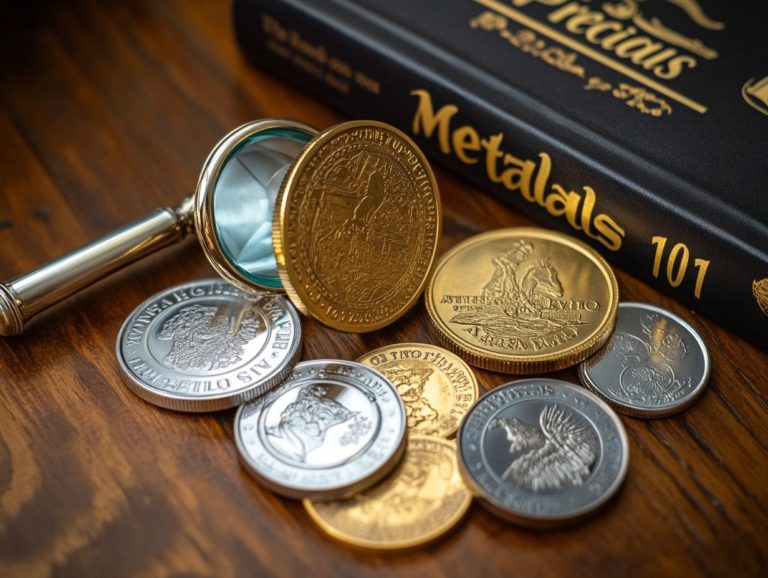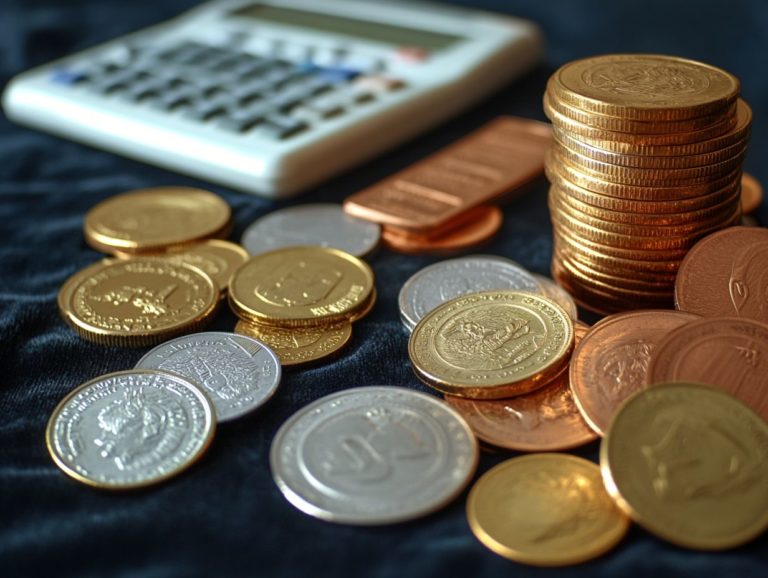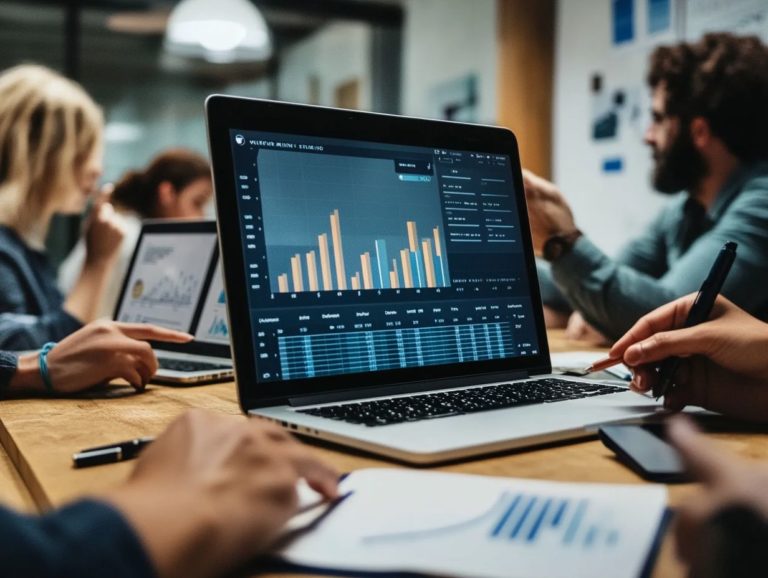5 Strategies for Precious Metals in Retirement
In today s financial landscape, securing your retirement is crucial. Investing in precious metals offers a way to hedge against inflation and market swings.
This article outlines five strategies for adding precious metals to your retirement portfolio. You ll learn about diversification and the associated benefits and risks.
It also covers how to decide on the right investment allocation, understand tax implications, and choose safe storage options. These insights will empower your investment choices!
Contents
- Key Takeaways:
- 1. Diversify Your Portfolio
- 2. Consider Investing in a Gold or Silver IRA
- 3. Research the Different Types of Precious Metals
- 4. Keep Up with Market Trends
- 5. Consult with a Financial Advisor
- What Are the Benefits of Including Precious Metals in Your Retirement Portfolio?
- What Are the Risks of Investing in Precious Metals for Retirement?
- How Can One Determine the Right Allocation of Precious Metals in Their Portfolio?
- What Are the Tax Implications of Investing in Precious Metals for Retirement?
- What Are the Different Ways to Invest in Precious Metals for Retirement?
- How Can One Safely Store and Protect Their Precious Metals for Retirement?
- Frequently Asked Questions
- What are the five strategies for investing in precious metals during retirement?
- Why is diversification important when investing in precious metals for retirement?
- How does physical ownership of precious metals differ from other forms of investing?
- What is dollar-cost averaging and how can it benefit retirement investing in precious metals?
- When should rebalancing be considered in a precious metals retirement portfolio?
- Is it beneficial to hold onto precious metals for the long-term in a retirement portfolio?
Key Takeaways:
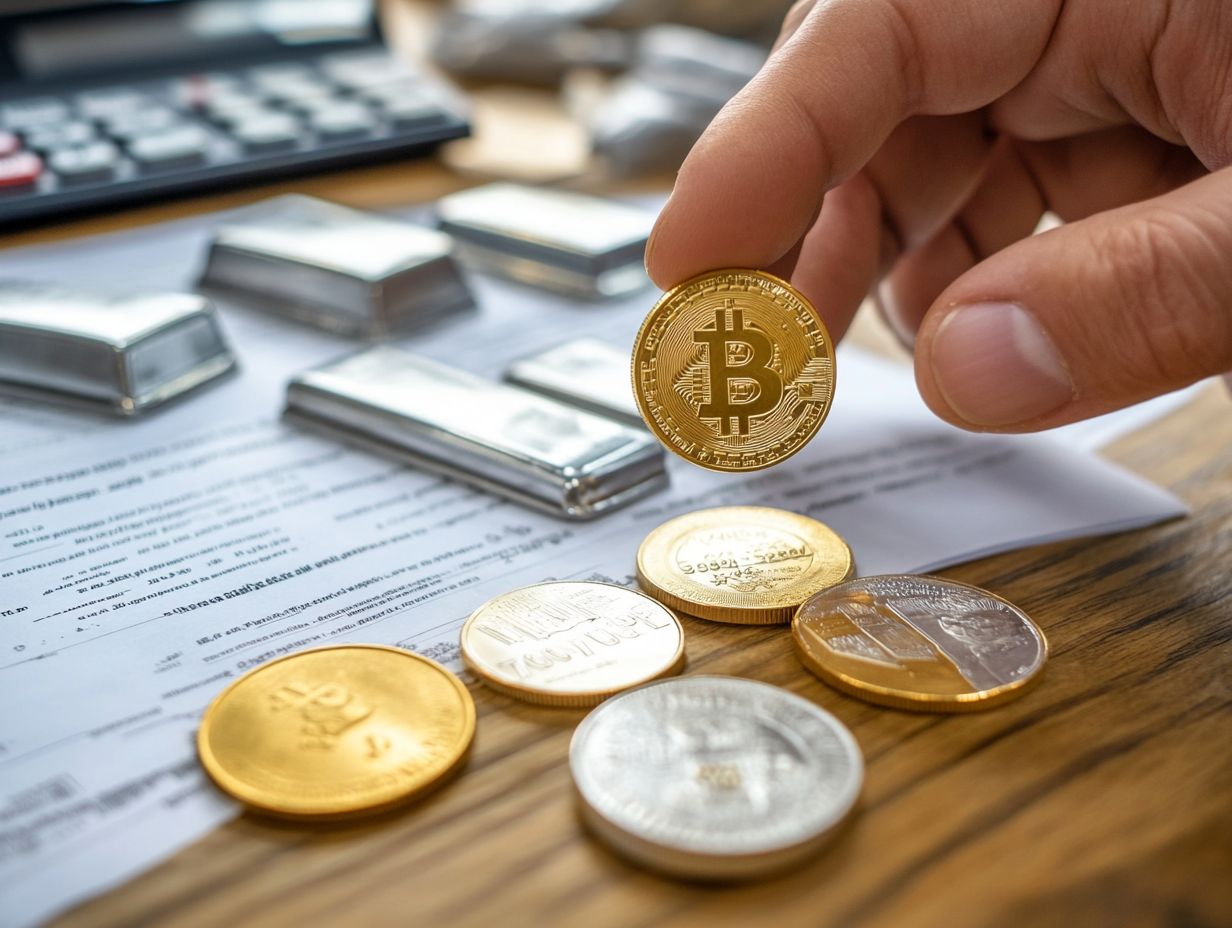
- Diversify your portfolio with precious metals to reduce risk and boost returns.
- Consider a Gold or Silver IRA for tax benefits and inflation protection.
- Research different types of precious metals to make informed choices.
1. Diversify Your Portfolio
Diversifying your investments is key to growing your retirement savings. This strategy helps manage risks and enhances potential growth.
By spreading investments across various asset classes like stocks and bonds, you can achieve better balance. Financial advisors can help design a strategy that fits your goals and risk appetite.
2. Consider Investing in a Gold or Silver IRA
A Gold or Silver IRA can significantly benefit your retirement. Precious metals often act as a reliable safeguard against inflation and economic instability.
This option diversifies your portfolio and gives you more control over your assets. You can choose metals that align with your financial goals and enjoy potential tax advantages.
3. Research the Different Types of Precious Metals
Knowing various precious metals like gold coins, bullion, silver, and numismatic coins is vital for building a solid retirement portfolio. Each has unique benefits and return potentials.
For example, gold is seen as a stable asset during downturns, while silver is often more affordable and can grow in value. Additionally, tax strategies for precious metals in today’s market can enhance your understanding of how to maximize these investments. Numismatic coins can appreciate due to their rarity, adding an interesting dimension to your investments.
4. Keep Up with Market Trends
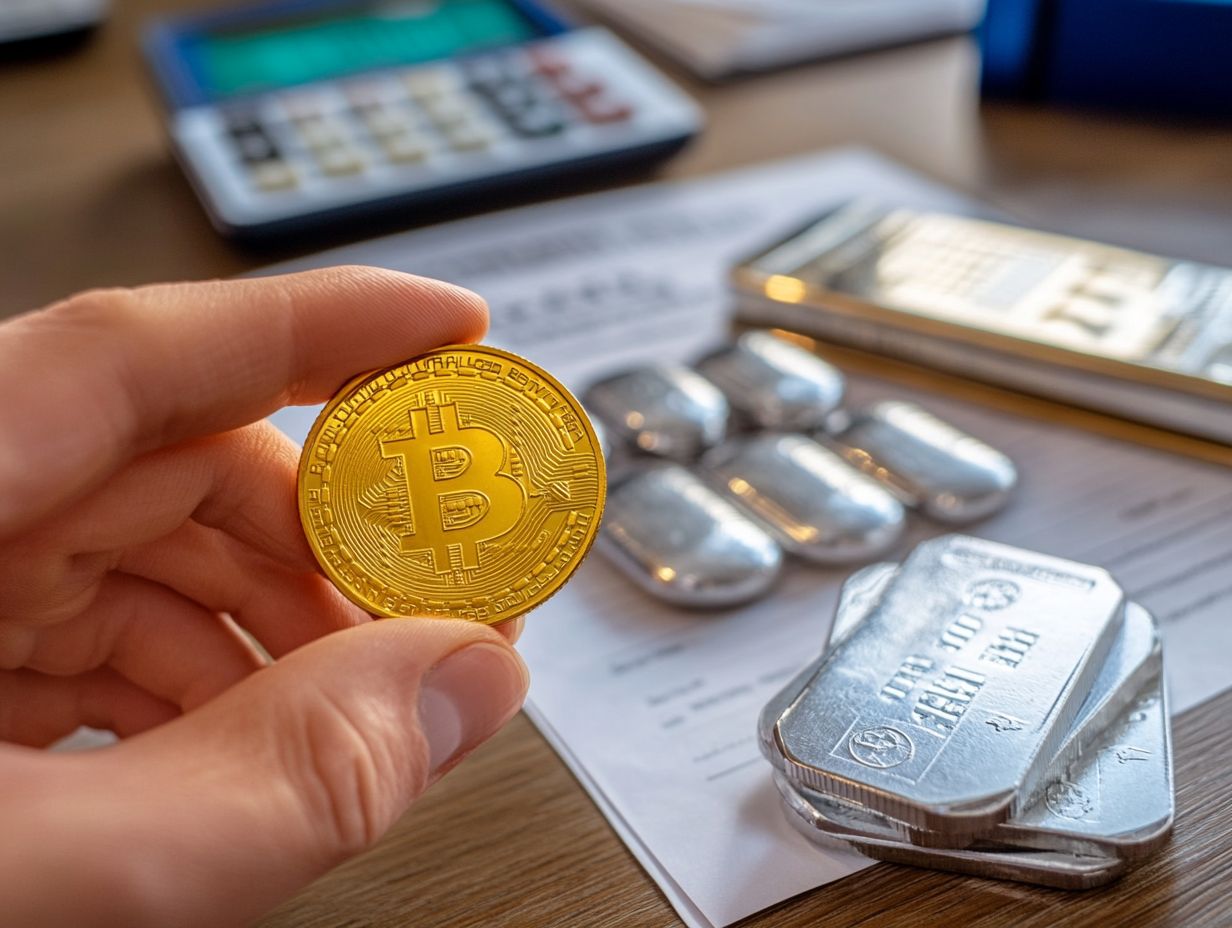
Staying informed about market trends is essential for you as an investor. Awareness can significantly influence both risks and opportunities associated with assets like gold stocks and commodities.
By closely observing fluctuations and patterns in market behavior, you can uncover crucial insights that will shape your future decisions. Understanding market behavior helps you navigate uncertainty more effectively, allowing you to spot potential pitfalls and seize emerging trends.
Recognizing the inherent volatility in various sectors enables you to implement better risk management strategies, ultimately protecting your investments. Engaging with a diverse range of data sources from financial news to analytical tools ensures you remain adaptable and ready to adjust your strategies as market conditions shift.
Ultimately, this proactive approach to monitoring trends sharpens your decision-making and fortifies the resilience of your overall portfolio.
5. Consult with a Financial Advisor
Consulting with a financial advisor is essential as you navigate the complexities of investment management, especially regarding retirement accounts. Understanding commissions and fees is crucial for maximizing your returns.
These professionals can provide investment strategies tailored specifically to your financial goals and risk tolerance, helping you make sense of the many options available. By working with registered advisors, you ensure compliance with regulatory standards, adding an extra layer of security to your investment decisions.
Knowledgeable IRA custodians play a critical role in safeguarding your assets, ensuring that contributions, distributions, and tax implications are managed appropriately. This collaborative approach enhances your prospects for long-term wealth accumulation and highlights the importance of professional guidance in achieving your financial objectives.
What Are the Benefits of Including Precious Metals in Your Retirement Portfolio?
Including precious metals in your retirement portfolio can bring a wealth of benefits. They serve as a protection against rising prices and contribute to economic stability, enhancing your overall portfolio diversification with tangible assets like gold and silver.
These metals have a proven track record of retaining their value, making them a dependable option during uncertain times. For example, when stock markets experience fluctuations or economies encounter recessions, precious metals often act as a buffer, helping you mitigate potential losses. Additionally, understanding the tax regulations for precious metals in retirement accounts can further enhance your investment strategy.
By diversifying with gold and silver, you can spread risk across various asset classes, effectively reducing overall volatility in your investment strategy. This advantage becomes particularly clear during inflationary periods, when the value of traditional currencies may decline, emphasizing the role of precious metals in protecting your purchasing power and securing your financial future. However, it’s important to consider the tax consequences of trading precious metals to ensure your investment decisions are well-informed.
What Are the Risks of Investing in Precious Metals for Retirement?
Investing in precious metals can be thrilling but has its risks, including market volatility and fluctuations that can influence the value of your gold-backed assets. You also need to navigate the challenges associated with storing and securing physical metals.
Additionally, it s essential to be aware of the potential for significant markups when purchasing these assets, which can eat into your overall returns. The lack of liquidity in certain markets means that converting these investments back into cash can often be trickier than you might expect.
Security is another crucial consideration; storing precious metals at home can expose them to theft risks, while relying on third-party storage facilities might introduce its own set of risks. Taking all these factors into account is vital for crafting a well-rounded investment strategy.
Don’t wait take control of your financial future today!
How Can One Determine the Right Allocation of Precious Metals in Their Portfolio?

Determining the right allocation of precious metals in your portfolio requires thoughtful consideration of your overall investment strategy, risk tolerance, and long-term financial goals. It s often beneficial to consult with financial advisors.
Understanding the various methods for how you spread your investments is essential, as it gives you the power to strike a balance between risk and potential returns. By evaluating your individual risk management strategies, you can pinpoint areas for adjustment in response to market fluctuations.
Aligning your investments in precious metals like gold or silver with your broader financial plans ensures they function not just as a hedge against inflation but also as a strategic element that enhances your portfolio’s resilience and performance over time. Understanding tax strategies for precious metals in emerging markets can further optimize your investment outcomes.
What Are the Tax Implications of Investing in Precious Metals for Retirement?
Investing in precious metals through retirement accounts, such as a gold IRA, offers unique tax advantages. However, it s crucial to understand the IRS rules governing these investments to truly maximize their benefits.
Adding precious metals to your retirement savings can really affect your long-term growth and financial security. Different retirement accounts, like traditional IRAs and Roth IRAs, treat these tangible assets differently, which can influence your withdrawal rules and tax rates. Understanding tax strategies for precious metals in a diversified portfolio is crucial for effective planning.
For example, while traditional IRAs may allow for tax-deferred growth, withdrawals during retirement are taxed at your regular income rates. On the flip side, with a Roth IRA, your contributions are taxed upfront, but qualified distributions are tax-free.
Understanding IRS regulations is crucial for optimizing your investment strategies and potentially enhancing your overall retirement savings.
What Are the Different Ways to Invest in Precious Metals for Retirement?
There are numerous ways for you to invest in precious metals for retirement, including options like gold stocks, gold ETFs, and specialized accounts such as a gold SIPP. Each of these choices comes with its own distinct benefits and considerations.
Navigating these options might feel overwhelming, but examining their unique attributes makes it easier. For instance, gold stocks can provide exposure to the price movements of gold while potentially offering dividends. However, keep in mind they can also be influenced by market volatility and the performance of individual companies. To enhance your understanding, consider exploring tax strategies for investing in precious metals ETFs.
In contrast, gold ETFs present a more straightforward way to engage with gold, often accompanied by lower management fees. Still, they are not immune to market risks. The gold SIPP offers tax efficiency and a personalized approach to your investment strategy, but it may come with its own restrictions and fees, warranting careful consideration. To enhance your investment, consider exploring tax strategies for maximizing returns in precious metals.
By understanding how each of these fits into your comprehensive retirement strategy balancing risk with potential returns, you can make more informed decisions that align with your financial goals, especially when considering tax strategies for precious metals in a changing economy.
How Can One Safely Store and Protect Their Precious Metals for Retirement?
Safely storing and protecting your precious metals for retirement is important. Utilizing reputable IRA custodians can provide security and peace of mind while keeping commissions and fees associated with storage to a minimum.
These custodians are integral to your overall strategy, ensuring that your metals are securely housed in insured facilities, thereby safeguarding against theft or loss. Take the time to compare different custodians to find the best fit for your needs, considering their service fees and the level of insurance they provide.
You should also explore various storage options, such as segregated versus pooled storage, to find the choice that best aligns with your investment goals. By focusing on these best practices, you can achieve both safety and efficiency in your precious metals investment strategy.
Frequently Asked Questions
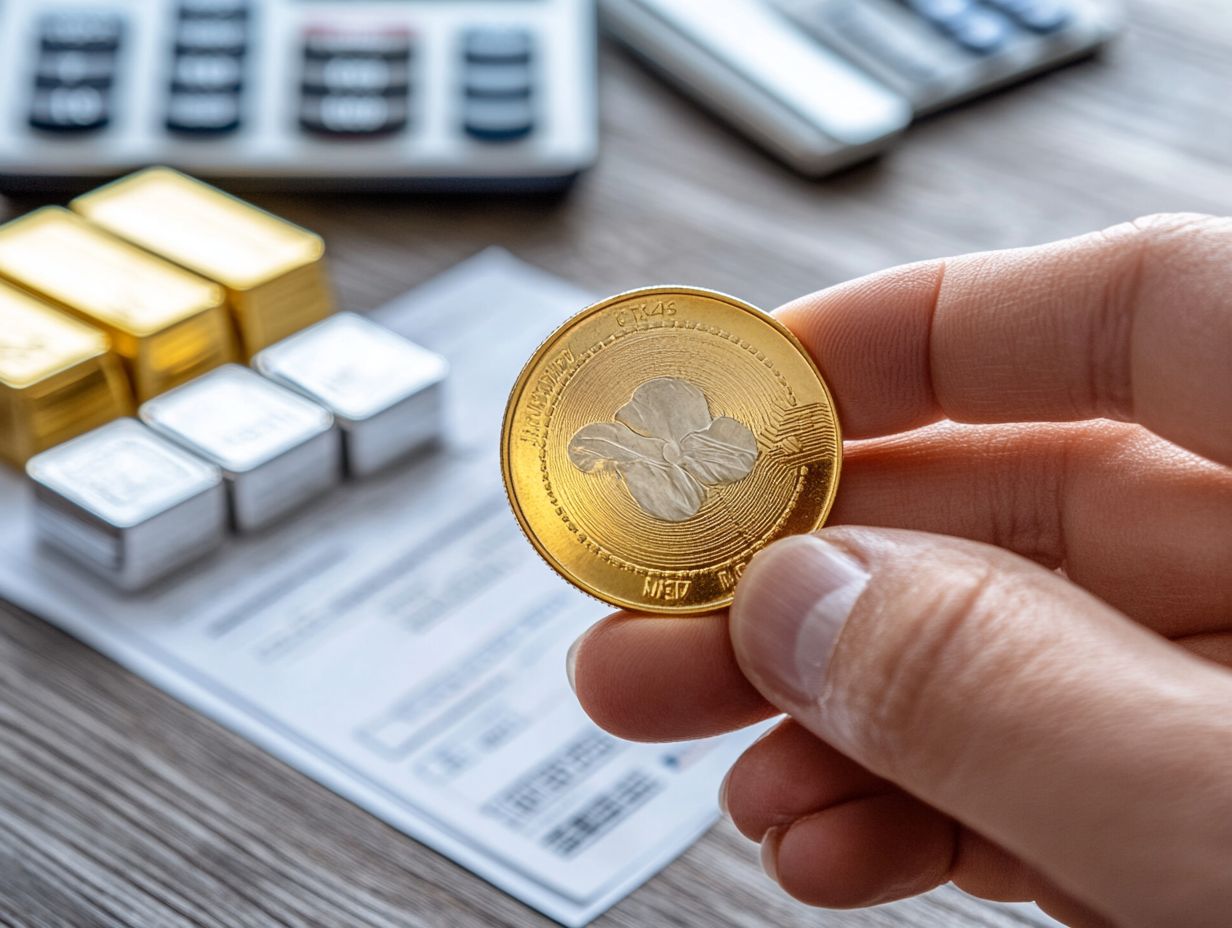
What are the five strategies for investing in precious metals during retirement?
The five strategies are diversification, physical ownership, dollar-cost averaging, rebalancing, and long-term holding.
Why is diversification important when investing in precious metals for retirement?
Diversification helps reduce risk and balances potential losses. Investing in various precious metals protects your retirement portfolio from market fluctuations.
How does physical ownership of precious metals differ from other forms of investing?
Physical ownership means buying and possessing precious metals like gold or silver coins or bars. This differs from other investments where you might not physically own the asset.
What is dollar-cost averaging and how can it benefit retirement investing in precious metals?
Dollar-cost averaging means investing a fixed amount regularly, regardless of market price. This strategy lowers the risk of buying at high prices and can lead to potential gains over time.
When should rebalancing be considered in a precious metals retirement portfolio?
Rebalancing should occur when the allocation of precious metals deviates significantly from your target. It maintains a balance of risk and potential returns.
Is it beneficial to hold onto precious metals for the long-term in a retirement portfolio?
Yes! Holding onto precious metals long-term can provide stability and protection against inflation. Regularly review your portfolio to seize opportunities!










